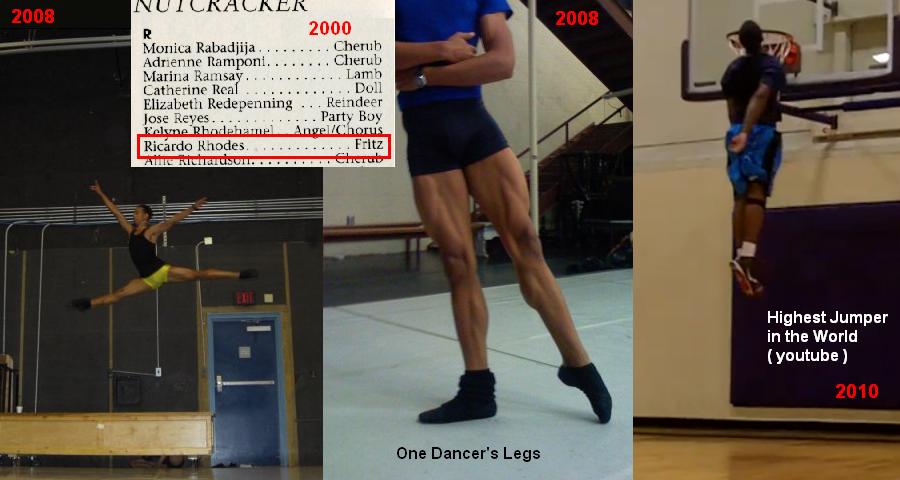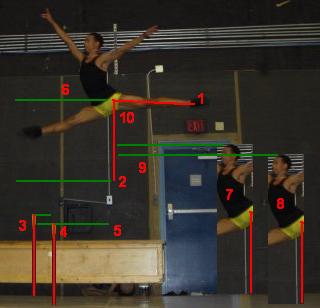
How High Can a Dancer Leap?
How do you measure height, anyway? Basketball players might want to go by maximum reach, as to be able to place the ball in the basket as opposed to having to aim and throw. I take it that dancers judge jump height in a similar manner as for track and field events, being able to clear an imaginary bar or hurdle but just for a moment.
Many male ballet dancers can clear five feet with torso upright and legs spread horizontally. They say Mikhail Baryshnikov could clear six feet on a good day (1).
This would put the dancer's center of gravity about 5-1/2 feet above ground (6-1/2' for Mikhail). Now he starts from a squatting position (a deep plie in ballet terms) which has his center of gravity about 2 feet above ground. So the total rise is 3-1/2 to 4-1/2 feet. The center of gravity is higher with legs split horizontally compared with legs hanging down.

The dancer's pose shown is generally during a jump with a slow running start. We believe that the dancer pictured did a vertical jump using both legs and, while in the air, assumed the pose as shown. This appears to be a show-off session as opposed to a rehearsal.
The basketball player pictured on the right is 5'-10" tall and has the top of his head slightly above the 10 foot rim of the basket. This puts his center of gravity around 7-1/2 feet above ground. He, too, started from a nearly stationary squat with center of gravity around 2 feet above ground, producing a net rise of about 5-1/2 feet.
High jumpers go over the bar head first and backwards. With the entire body curved, arcing over the bar, the center of gravity is about the same as or slightly above the bar height. (As his pelvis passes over the bar he is starting to drop so he quickly pulls his knees around to his chest so his legs do not hit the bar.) Meanwhile classsical dancers almost always have the upper body upright during jumps. The high jump from a stationary (standing, squatting) position is no longer included in Olympic sports. With a running start, the record for a high jump is clearing a bar about 8 feet above ground. Notice that for the standard (running) high jump and also the ballet grand jete, only one leg is used to perform the jump.
Highest Jumper in the World?

Let's analyze the preceding picture to estimate how high the dancer jumped.
Step 1. Measure the dancer's leg from heel to hip joint.Step 2. Project the leg extension downward.
Step 3. Show the leg length from heel to hip joint down on the floor.
Step 4. In step 3 the dancer would be standing against the back wall. In reality he is closer to the viewer so we show the leg position differently.
Step 5. Measure the floor standing level of the hip joint.
Step 6. Compare with the level of the hip joint of the dancer in the air.
Alternate method:
Step 7. After step 2, project the dancer's entire body at floor level.Step 8. As with step 3, step 7 assumes he is at the back wall. He appears too large for the door which means he must be standing closer to the viewer so we show him that way.
Step 9. Measure his height as standing on the floor.
Step 10. Compare with his crotch in the actual jump. We estimate that his crotch cleared one and a half to two heads (about 15 to 20 inches) above his floor standing height. Or compare head height of the floor level projection with head height of the actual pose.
You can draw your own conclusions but I would estimate that the top of the dancer's head is somewhere around ten feet above the floor. Note that this is a quick and dirty analysis. To be more precise, we may need the help of an anatomist to better find the location of the hip joint and to extrapolate a better standing posture from the actual picture to get a more accurate standing height.
"Wait a minute!" you might ask. Isn't there an optical illusion given the photographer's camera angle making the dancer seem higher than he really is? However (perhaps by printing copies of the picture and cutting with scissors) you can't move his body to produce a floor level position with a smaller difference between standing head height and in-the-air head height. Since some of the floor is visible, the vantage point has to be above floor level.
(Five foot eight inches is considered short for a male ballet dancer (2). The dancer pictured here has not been described as short so 5'10" is a reasonble worst case height if you want to consider how high his head reached.)
A dancer may achieve a higher jump if he concentrates on doing just that. But you won't see extremely high jumps on stage often because the entire jump has to look graceful. Also the higher he leaps, the faster and harder he comes down. He has only his thin leather ballet slippers and his leg muscles to cushion the landing, and no big pillow or soft sand pit to land in.
The time not in contact with the floor is rarely more than 3/4'th second.
Photo credits:
Left and Center: From the Facebook page, photo section, of Rickey Rhodes (Sarasota Ballet).
Right: Frame from a Youtube video of Haneef Munir
http://www.youtube.com/watch?v=SOZqi7vuVxU&feature=related
Inset: Boston Ballet Playbill program, December 2000.
Notes:
(1) A Straight Dope Classic from Cecil's Storehouse of Human Knowledge
"How high can classical dancers leap?"
http://www.straightdope.com/columns/read/88/how-high-can-classical-dancers-leap
(2) Boston Globe, Sept. 30, 2009
Native Talent, by Geoff Edgers
http://www.boston.com/ae/theater_arts/articles/2009/09/30/boston_ballet_to_showcase_a_talent_honed_in_the_hub/
Video with Ricardo Rhodes (2 min. 40 sec. in)
http://www.youtube.com/watch?v=A3jxqIq-6KY
Last updated June 4, 2012
Go to other, unrelated, topics
Contact us
All parts (c) copyright 2012, Allan W. Jayne, Jr. unless otherwise noted or other origin stated.
If you would like to contribute an idea for our web pages, please send us an e-mail. Sorry, but due to the volume of e-mail we cannot reply personally to all inquiries.